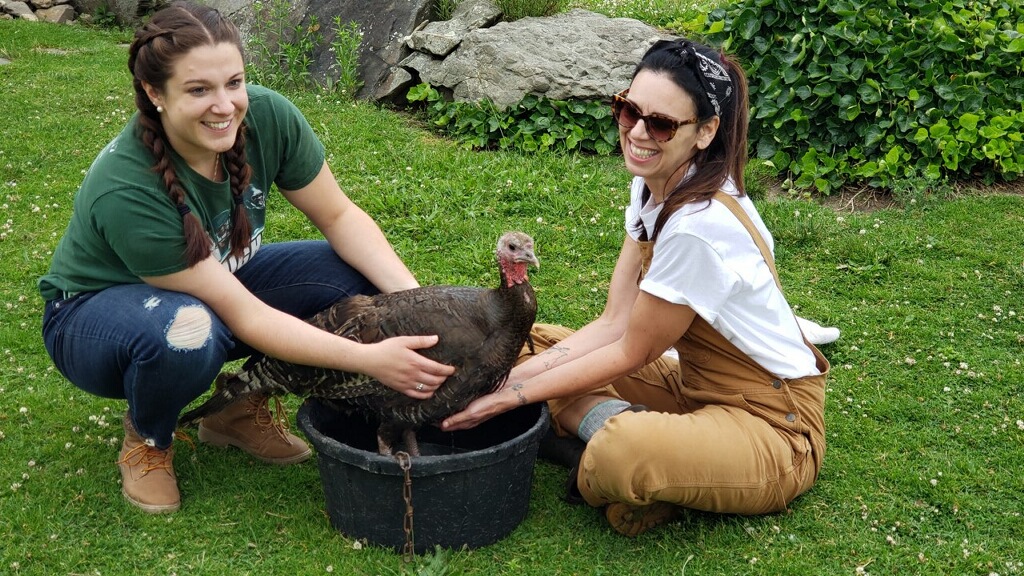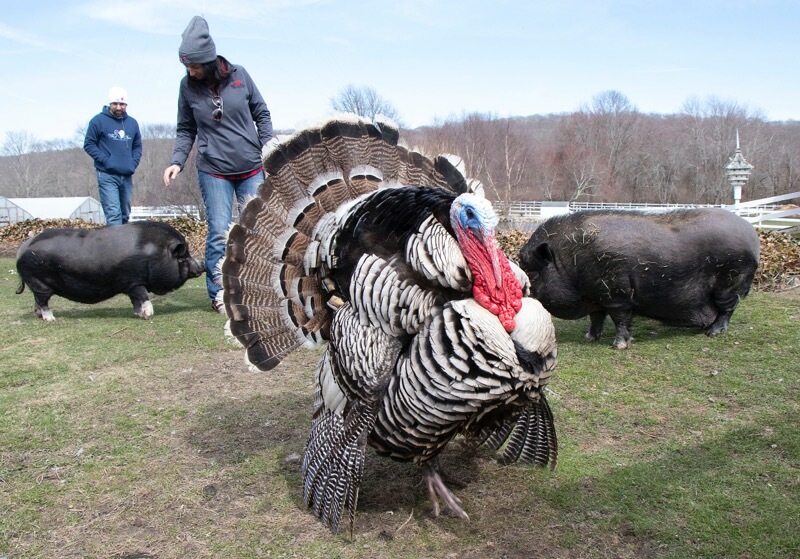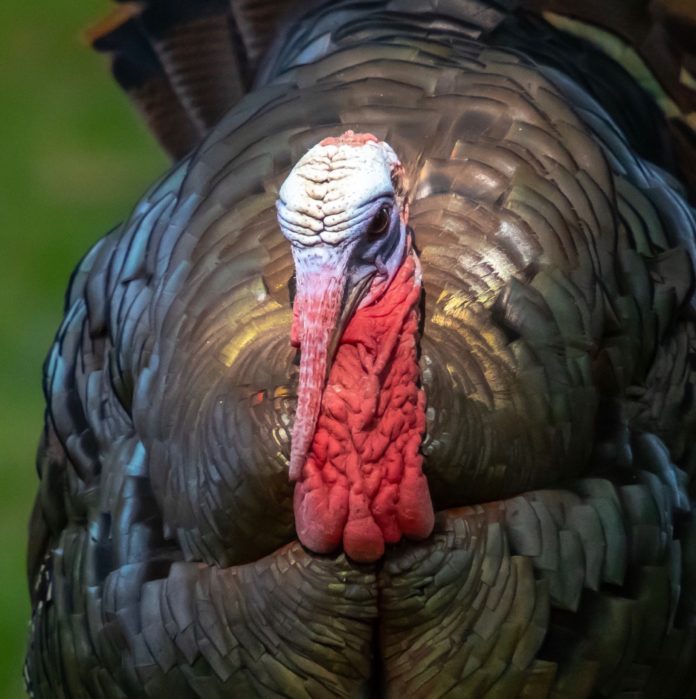Northern, RI – At dawn or dusk, driving or strolling down most any suburban or rural northern Rhode Island road, one might spot a hungry family of turkeys searching for something to eat and hear their melodic, “gobble-gobble,” or even witness a burst of silky brown, gray, and blue as they flap their iridescent feathers in flight into the trees.
“Wild turkeys are wandering foragers and will make their way through the landscape – sometimes alone and sometimes in large groups – looking for nuts, seeds, and invertebrates,” said Kim Calcagno, refuge manager for Audubon Society of Rhode Island at Powder Mill Ledges Refuge in Smithfield and Florence Sutherland Fort, and Richard Knight Fort Nature Refuge in North Smithfield. “Like chickens, they will scratch at the ground to expose food items.”
Folks who feed the songbirds in their yards might get visited by turkeys.
“They will certainly take advantage of free food at a human’s bird feeders,” Calcagno said.
What of the seemingly lone turkey wandering along a road or in a backyard?
The solitary feathered figure is likely a male who’s, “switching flocks,” says Wendy Taylor, wildlife rehabilitator, and founder and executive director of West Place Animal Sanctuary in Tiverton.
Taylor explains that, unlike Canada goose and some other types of birds, turkeys do not have a companion for life. Instead, males fertilize, and they don’t raise the family, or ward off predators as do male mallard ducks, swans, and geese.
On occasion a turkey might follow a person or people.
“Most of the time, they will take no interest in humans other than to move away from them,” said Calcagno. “We are large predators in their eyes.”
“Occasionally, you may see males displaying for females with their bodies puffed up and their beautiful tails fanned out and their faces bright red and blue,” Calcagno explained. “Turkeys are ‘lekking’ birds. Males will defend a display ground or ‘lek’ during mating season from other males. Here they will parade around and perform their display for the females and sometimes spar with other males. Humans should avoid getting close to these territorial males.”
Taylor says sometimes turkeys follow people out of curiosity or because someone has food. An individual turkey might try to intimidate to establish dominance. Sometimes, that depends on the particular bird’s personality, as Taylor knows well.
For example, Taylor’s feathered friend, “Smoky,” was a colorful and robust-looking turkey, a beloved resident at West Place. He was a big boy who playfully or with authority brushed up against people’s legs, kind of like a cat does, but to show he was the boss, she explained.
Smoky was a Narragansett turkey. Calcagno says the wild turkeys of North America are all the same species: Meleagris gallopavo, though our Eastern Wild Turkey is one of the many subspecies, silvestris, noted throughout the country. Meleagris gallopavo silvestris is notably the genetic base for the Narragansett Turkey, which is a domestic breed developed in the 1800s right here in Rhode Island. They resemble a wild turkey, but have a whiter, ‘tint,’ to them, as their feather tips are white or gray, compared to the wild type black coloration.

Taylor tells a story of another turkey she and others cared for at West Place – Tat, who was, “extremely sociable.” In fact, Taylor says of the bronze turkey, “she was awesome.”
Tat came from a neglect situation. As a baby, she was a, “failure to thrive,” who was beaten upon by bigger birds. She had brittle bones and her wing had to be amputated. At West Place, the former abuse victim had human and animal friends, and loved for Taylor or other humans to massage her, and she loved when her people gave her a bath. The bird loved people more than her own kind, says Taylor. Tat’s life ended not long ago, Taylor said, and her West Place friends, animals and people, mourned for her and for Smoky.
No, “bird brains,” turkeys are intelligent, according to no less an intellectual than a founding father of America. Benjamin Franklin nominated the turkey as the national bird. Alas to his dismay, the Bald Eagle was chosen instead. In a letter to his daughter Franklin wrote:
For the Truth the Turkey is in comparison a much more respectable bird, and withal a true original Native of America… He is besides, though a little vain and silly, a Bird of Courage, and would not hesitate to attack a Grenadier of the British Guards who should presume to invade his farm yard with a red coat on.”
It seems George Washington shared Franklin’s high opinion of turkeys. And the turkey troops can fly, but not high.
“They can propel themselves into the air in short, powerful bursts,” reports Earth Eclipse. “This helps them to escape predators and to reach branches for roosting overnight, away from dangers. They aim to usually fly just high enough to reach the primary branches of broad-leaved trees. Sometimes, they can go as high as 15 m (50 feet) off the ground.”
The wild turkeys’ bald-looking, pale domesticated relatives, sold at the supermarket and bred for the table, have, “meaty,” chests, so their bodies are too heavy for the birds to go airborne. The keeping of birds seems to have started when Native Americans, the Navajo, unable to keep hungry turkeys from munching on the corn growing in cultivated fields, fenced in the turkeys. The birds were kept confined for their feathers and to eat them, and were deemed symbols of friendship and God’s providence.
Perhaps ironically, in light of this history, a study found that corn might possibly present a problem to turkeys. The study, Neonicotinoid detection in wild turkeys (Meleagris gallopavo silvestris) in Ontario, Canada, showed pesticides known as neonicotinoids, banned or restricted for toxicity in some places in the world, were found, “in the livers of wild turkeys,” reported Chromatography Today in 2018.
Long before 2018 in Providence County, according to Census of Rhode Island 1895, 88 turkeys raised in Glocester were valued at $215, and 37 turkeys raised in Burrillville at $62.50.
Today wild and heritage turkeys, as meat, are purchasable at an exotic meat market for $149.99 for minimum weight of six pounds, and $139 for up to twelve pounds.
Once abundant, turkey populations dwindled in America in the 19th century, and perhaps the lowest point by 1930s.
“New England hunters, lumbermen and farmers had driven the wild Meleagris gallopavo to near extinction,” according to New England Historical Society, which reported that the, “fatal vulnerability,” of the turkey is that they do not migrate.
By 1975, however, “restoration efforts were in full swing in the Northeast,” according to Wild Turkey Harvest Management: Biology, Strategies, and Techniques by William Healy of the U.S. Forest Service. Calculating the number of turkeys is challenging; for turkeys are, “inconspicuous, mobile, and wide ranging,” wrote Healy.
Restoring the turkey population in America began with the invention of the cannon net, seen in use here.
Invented in 1948 by H.H. Dill and W.H. Thornsbery, the cannon net traps large numbers of birds all at once, according to Restoring America’s Wildlife 1937-1987 by the U.S. Department of the Interior, Fish and Wildlife Service.
Rhode Island’s Department of Environmental Management’s Division of Fish and Wildlife conducts surveys of the turkeys and urges the public to help by reporting turkey sightings. In the smallest state, by 1980, restoration of wild turkeys began when 29 of the birds were trapped and transferred from Vermont to Exeter. By the 1990s, “utilizing harvest data, brood reports, cooperator sightings, call count surveys, track and sign surveys it was apparent that certain areas of the state held few or any turkeys and that the release of new flocks was warranted. Three sights were chosen for releases, Black Hut Management Area in Burrillville and two large privately owned parcels; one in West Greenwich and the other in Little Compton,” reported blogger Wayne Barber at My Northwest Rhode Island. Birds were also released in Foster, Scituate, West Greenwich, and Tiverton.
At one point, there were enough wild birds in New England to once again justify spring turkey hunting in each state.
“Populations have rebounded so strongly that highly regulated, sustainable harvest of wild turkeys has been reinstated in Rhode Island.” stated RIDEM on the, “Wild Turkey” page on their website.
“One of the good things about Rhode Island’s small size is that it doesn’t take long for wildlife-restoration projects to pay off,” reported Field & Stream magazine in 1997. “Witness the state’s turkey-restoration program, which in the past five years has basically achieved statewide distribution of a species that had basically been extirpated. Huntable populations of turkeys are now present almost throughout the state.”
The turkey population in Rhode Island grew.

“So well, in fact, that state wildlife administrators have suspended the few trap-and-transplant stockings that remained on their schedule,” Field & Stream magazine reported in 1998. “The work is finished now, Rhode Island wildlife officials are simply waiting for hunters to reap the spring gobbler harvest the state has been busy planting,”
The state’s, “gobbler harvest,” as it’s known in the hunting world, increased by 52 percent from the previous year’s turkey hunt; a significant number of flocks were sighted, and the hunting trend was increasing.
By 2002, some 6,000 turkeys roamed around Little Rhody, reported The Providence Journal.
“Once locally extirpated, the wild turkey now occupies most of the state,” stated RIDEM Division of Fish and Wildlife. “Recent changes to the bag limits have increased hunting opportunity resulting in an increased turkey harvest for the springs of 2019 to 2021. While fluctuations in the harvest occur, long term trends are positive. Rhode Island turkey hunters indicate that they are satisfied with the spring bag limits and the hunting opportunity provided to them. Like harvest trends, brood index estimates fluctuate from year to year. The 2021 brood index estimate is good, above the 10-year average, and has not changed significantly over the past 16 years.”
The 2022 Rhode Island Youth Wild Turkey Hunt, “was a major success,” is the headline on a page of the Light Foundation, which reported “a 130 percent success rate. All ten of the youth hunters had a great day; thirteen turkeys were harvested and three of the hunters actually bagged a second bird at the request of a landowner. Seven of the aspiring hunters were new to the game and witnessed their very first turkey hunt during this program.”
In the Rhode Island 2021 spring turkey season – from April 28 to May 22, “hunters reported 282 birds, a 5.2 percent increase from the 268 turkeys during the 2020 season,” according to Realtree.com.
What’s more, in 2021, the highest harvests of wild turkeys were taken in Burrillville, at 29; Exeter, at 23; Glocester, at 23; Coventry, at 21; and Foster, at 21, reported Realtree.
A person might encounter a turkey family or more along a rural road, and, “turkeys are common enough these days that they can be seen in just about any greenspace such as one of our Audubon refuges, city and state parks, agricultural fields, and in the heart of suburbia,” reveals Calcagno. “They like to forage in both field and forest areas. There are a number of them that are a nearly permanent fixture on the grounds of our Nature Center and Aquarium in Bristol at 1401 Hope St.”
“Wild places are ever fewer and wild creatures are increasingly forced into smaller and more fragmented areas,” explained Calcagno. “We advocate for landowners to manage their properties to be healthy, functioning ecosystems that are more welcoming to wildlife. We are very much connected to other living things, and we need to make sure they have enough space and resources to thrive.”









It’s not Canadian Geese. It’s not their nationality. The name of the bird is Canada Goose
Thank you – we have made the correction.